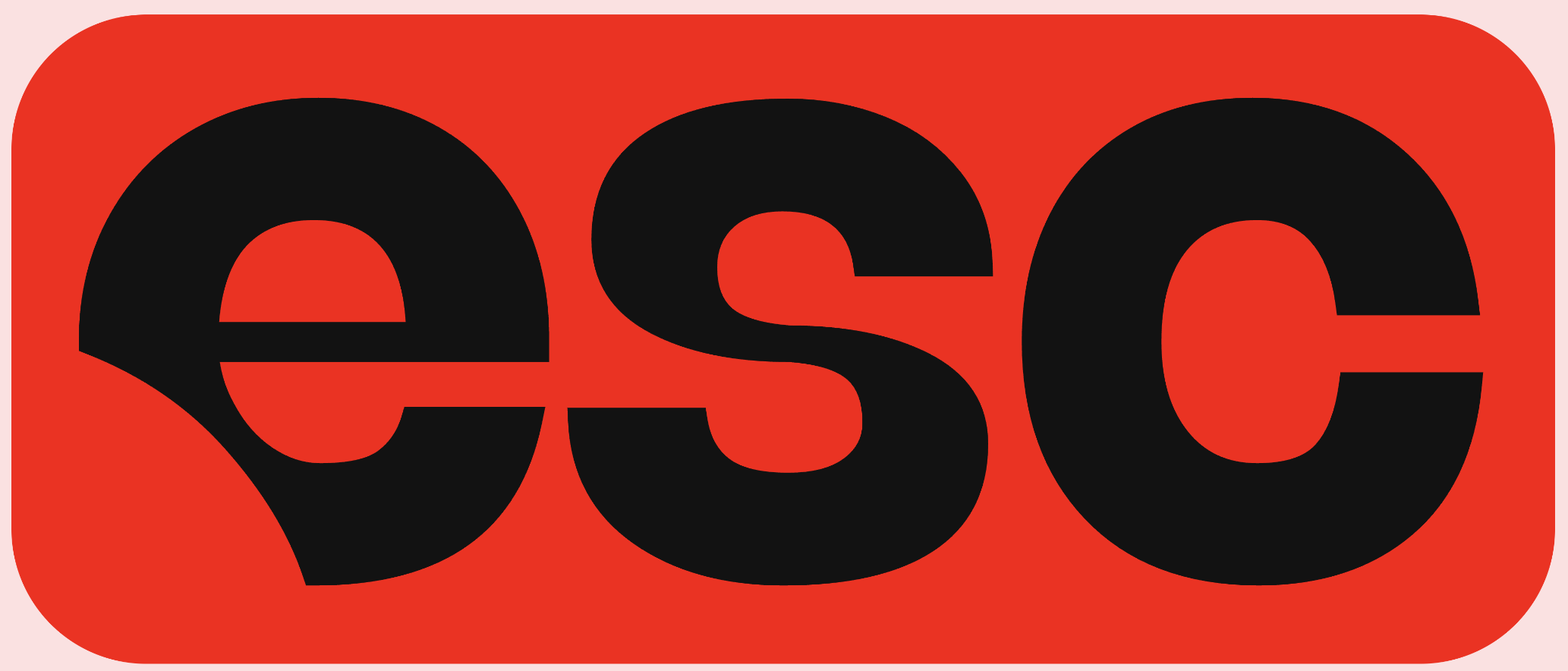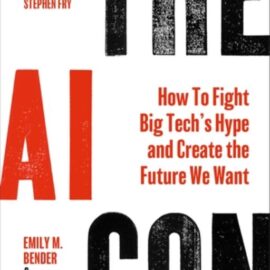Do you believe in hope after “AI” hype? Emily M. Bender and Alex Hanna make the case
In this extended briefing, “TL;DR” = “Totally Legit; Def. Read” because we review “The AI Con,” the spicy new book ready to rattle the broligarchy. Plus, the authors answer ESC KEY .CO’s questions about creative work — giving you something hot to talk about at your next power lunch, as ever. *Wink.*

The thing is:
“AI” is a sinister bubble pumped full of VC-grade helium. The business guys inhaling it — dizzy, cocksure — are pressuring creative workers to take a hit, too. The cartoonish repetition of ungrounded claims starts to resemble that old BuzzFeed video, “People Inhale Helium For The First Time.” But unlike that bit of peak 2010s millennial-core fluff, this hype is no joke — it’s a distraction from real, current harms. Too much helium? You're bound to lose consciousness.
“The hype-mongers not only spin fantastical tales about what the tech can do, but they also work to convince you that if you don’t jump on the bandwagon, you’ll be left in the dust,” write Emily M. Bender and Alex Hanna in their cathartic, crisply argued and irreverently comedic new book, “The AI Con: How to Fight Big Tech’s Hype and Create the Future We Want.”
“If they couldn’t be bothered to write this, why should we be bothered to read it?”
I’ve breezed through an advance copy in the lead up to its U.K. release on May 22. It’s vintage Bender and Hanna lines like this that capture the painfully cringe experience of, say, logging onto LinkedIn in the year of our lord 2025: “Everyone on the bandwagon has to sing the same droning chant of AI mantras (‘Feel the AGI!’, ‘Democratizing AI!’), getting louder and louder.” And this one: “We find ourselves asking: If they couldn’t be bothered to write this, why should we be bothered to read it?”
What if you don’t want to take in mouthfuls of their gas or sing along in their chorus? Well, with the scornful tone of a smart friend about to reveal the juiciest gossip you’ve been dying to hear, “The AI Con” recounts some of the most popcorn-worthy reasons you might want to reject the hype.
Ergo, this is the kind of book that makes the broligarchs nervous, written by two of their most formidable critics. Bender, professor of linguistics at the University of Washington, co-authored the widely cited 2021 paper, “On the Dangers of Stochastic Parrots: Can Language Models Be Too Big? 🦜” (Yes, the parrot emoji is included in the official title.) In 2023 she landed on the inaugural TIME100 AI list of most influential people. Hanna formerly worked as senior research scientist on Google’s Ethical AI team. Now, she is director of research at the Distributed AI Research Institute (DAIR), the non-profit founded by Timnit Gebru, former technical co-lead of the Ethical AI Team. (Google ultimately fired Gebru due to the publication of the “Stochastic Parrots” paper, which she co-authored.) At DAIR, Hanna centers the communities most impacted by technology in her research.
Together on their podcast, Mystery AI Hype Theater 3000, Bender and Hanna have earned an enthusiastic following for speaking some sense in the age of “AI” — surely, a marketing term neither would use without the obligatory scare quotes.
“Surprisingly many people, especially those in positions of power, seemingly want to be the naked emperors.”
But their book is not merely a roast or a repeat of their greatest podcast hits, as delicious as those moments can be. Bender and Hanna also acknowledge that in everyday life, resisting the intrusion of “AI” ultimately requires speaking truth to power — and that’s not always so easy.
“To speak up to say the emperor has no clothes is difficult,” Bender and Hanna write. “And it is doubly so when surprisingly many people, especially those in positions of power, seemingly want to be the naked emperors. That is, they want to believe the hype and convince everyone around to join them.”
Thankfully, as they proclaim at the preface of “The AI Con” — and in the intro to their podcast — they’re here to pop the hype “with the sharpest needles we can find!” And they’re handing out needles, too, by filling the book with strategies and examples of resistance from unionizing writers through to creatives “spoiling” the training data for diffusion models. It’s as precise and detailed as it is witty and accessible.
“The AI Con” is the field guide you’ve been waiting for to navigate this brave new world, with some hope for what might follow the bubble’s dramatic pop.
The thing about that is:
The problem begins with thinking about “AI” as one super-powerful technology when it is, in fact, a marketing term that clusters together a lot of different technologies under one umbrella. Confusing, yes! At present, when people say, “AI,” many are primarily referring to large language models (LLMs) that power chatbots like OpenAI’s ChatGPT, Microsoft’s Copilot, Google’s Gemini and Anthropic’s Claude. But even an accurate understanding of LLMs requires thinking beyond the PR messaging that suggests it’s a digital product somewhere in the ether.
“This term AI is not a singular thing,” Hanna told Business Insider last week in an interview alongside her co-author. “Just like fast fashion or chocolate production, a whole host of people are involved in maintaining this supply chain,” she said.
“We were not previously aware that management was monitoring our members’ ChatGPT usage. We are concerned about this data collection.”
And yet, another part of the problem is the media repeating the “AI” boosters’ claims in their reporting — or being compelled to use it behind the scenes by bosses. At least one leading online business publisher is even ranking its employees based on their time using chatbots. Three days after Business Insider published its interview with Hanna and Bender, Nieman Lab reported that Insider’s management was pushing its staff to use Enterprise ChatGPT. The report revealed that an all-hands meeting in late April had included the presentation of a leaderboard of employees, naming the top 10 based on their chatbot use. “We were not previously aware that management was monitoring our members’ ChatGPT usage. We are concerned about this data collection and will be requesting further information,” Morgan McFall-Johnsen, vice chair of the Insider Union, told Nieman Lab.
So pernicious is the hype that otherwise scrupulous media outlets have, at times, joined the chorus — often without much critical reporting on who really benefits from the Big Tech messaging and, crucially, who pays the considerable costs for the semblance of “automation” they sell. “Journalists have not yet penetrated the public consciousness with the idea that, actually, AI is a very physical technology,” investigative journalist Karen Hao told ESC KEY .CO in March, when she was gearing up for the release of another hotly anticipated book, “Empire of AI,” which is also out this week, on May 20. (The tech world has been “nervously waiting for it,” host Kevin Roose admitted in the introduction to, let’s say, an entertaining interview with The New York Times’ Hard Fork Podcast.)
“Silicon Valley really perpetuates the idea that AI exists in the cloud, that it exists in other worlds where it doesn't require our labor on Earth,” Hao told me when we spoke. But the opposite is true. The supply chain for inherently bullshitting LLMs relies on the theft of virtually all intellectual property on the internet, the exploitation of workers around the world and staggering environmental consequences.
But thankfully, the facade begins to collapse when you inspect it closely. And collective efforts to educate and resist can cut through the spin. Earlier this year, I logged on Zoom for a workshop with Hao through the Pulitzer Center’s AI Spotlight Series, which she co-leads. “Any journalist in any context, whether they are from a country developing it or having AI exported to them, should feel ownership of covering the way that AI is impacting their communities,” she told me, noting that the series has experienced demand that quickly outpaced the Pulitzer Center’s initial goals. It is an encouraging signal to see thousands of individual journalists so engaged. “I mean, literally, it’s affecting every possible beat in the world.”
“The main story about AI is the human one, not the technical one.”
Hanna and Bender cite Hao’s reporting and work with the Pulitzer Center as one example of how creative workers can resist the Big Tech media machine: “[Hao’s work training journalists] is critical, as it plans to unsettle the centrality of the tech narrative around the Global North and back to the Majority World, where much of the labor occurs,” they write in “The AI Con.”
It also aims to dispel the (intentional) obfuscation achieved by lumping all these technologies under ‘AI.’ And it ensures that the main story about AI is the human one, not the technical one.
Even when the media hops on the bandwagon, the tires sometimes roll off with great embarrassment to the journalists onboard. Last February, for instance, Bender was surprised to read a quote attributed to her about Blender Bot 3, a Meta chatbot. The only problem, she hadn’t said anything of the sort. In the fake synthetic quote, a “synthetic Bender” observed the tech company’s struggles to address misinformation. After emailing the publication requesting a retraction, the editor admitted: “Actually, we had prompted Gemini AI to create a story about Blenderbot 3’s latest blunder and it created this article misquoting you. Maybe Blenderbot and Gemini are not so different :)” — and, I mean, what an ironic moment to drop a smiley emoticon.
Where things get interesting:
“Some creative jobs maybe will go away, but maybe they shouldn’t have been there in the first place,” said Mira Murati, then OpenAI’s chief technology officer, last June while speaking at Dartmouth College’s school of engineering. It was billed as a conversation about how the tools her company sold could negatively affect people’s jobs.
Certainly, many in the creative industries have taken note of our Big Tech overlord’s apparent disdain, contempt and complete lack of understanding about what it means to be “creative.” Their “democratizing” doublespeak rings hallow when you see it for what it is: a claim that sounds nice but ultimately enriches the wealthiest people in the world. (Murati’s net worth is an estimated $1.4 billion.) It’s clear what they really mean by “democratizing creativity” is more something along the lines of “we want to steal your art, your prose, your poetry; we want to sell your bosses and clients tools that they’ll use to replace you; and even where you’re not outright replaced, the market for your work may tank as a result. And it is all done to line our pockets.” At Dartmouth, Murati simply said the quiet part out loud.
Consequently, what we might term creative industry n-AI-hilism is everywhere you look — the bitter cocktail of cynicism, pessimism and apathy that the tech is here and our careers are on the line due to a bunch of “freemium,” labor-breaking tools.
Among creative workers, this n-AI-hilism seems to follow several stages, akin to grief. It typically starts with disbelief (a la “that can’t possibly affect me! I’m a travel blogger and chatbots can’t travel!”). Then comes the justified defense (the blogger friend who said that later told me something to the effect of, “how dare my client, a travel agency, replace me with a chatbot!”). Next, it might look like posting “golden age of my industry” porn to LinkedIn. Or, for some tired creatives, it means throwing your hands up in the air (how many times have you read a LinkedIn post where somebody wrote, “AI is here, like it or not”). From there, the nihilistic tendencies seem to fork in two directions — either embrace the hype (“I’m launching a Substack about how to 10x your productivity with AI!”) or retire (“I will buy a house in an abandoned Italian village for one Euro!”).
It’s understandable that workers feel under siege. Tech journalist Brian Merchant, author of the Blood in the Machine newsletter, declared earlier this month that “the AI jobs crisis is here.” He was responding to news that Duolingo’s CEO recently said “[being an “AI-first” company] isn’t about replacing Duos with AI.” But a laid-off Duo admitted to Merchant that this was all spin. Job cuts had already been taking place. The translators were laid off in 2023, followed by the writers in October 2024. “If you had asked me a year ago, I would have told you that my job would become more and more editing AI content,” the fired Duolingo writer told Merchant. “I did not expect to be replaced so soon.”
All that is undeniable. But Bender and Hanna also aim to nudge you away from feeling total despair and defeat. Rather, “The AI Con” makes a more hopeful case for what workers and communities can achieve through individual and collective action.
Yet given the nihilistic tone in many creative fields at the moment, I wanted to hear directly from Bender and Hanna what they’d say to creative workers who increasingly feel like their jobs are on the frontline for cuts.
What’s the point of unpacking the hype if it’s costing us work in real time, a few impatient readers might wonder?
“I would hope that our book brings a sense of renewed possibility: both in terms of what can be achieved through solidarity and in terms of arguments that can be presented to those who buy synthetic media.”
“For the artists and other creative workers who are seeing their ability to cobble together workable careers severely disrupted by the people peddling ‘AI’ and those buying it, I would hope that our book brings a sense of renewed possibility: both in terms of what can be achieved through solidarity and in terms of arguments that can be presented to those who buy synthetic media,” Bender tells ESC KEY .CO.
In fact, this was one key audience they specifically wanted to reach, which is why the book weaves in a retelling of the Luddites, the 19th century textile workers who are widely misunderstood. They were not generally anti-technology. They were instead only against the technologies that worsened their craft and threatened their livelihoods. Luddites destroyed some machines with sledgehammers, the book recounts. But they left other tools untouched, ready to be used by human workers who genuinely benefited from them. Bender and Hanna draw a direct line from the Luddite’s protests to what the Hollywood writer’s strikes achieved in 2023. (Both of these examples, Luddites and Hollywood writer strikes, show that the strategy is targeted. It’s not that all tech is bad. For instance, this mildly dyslexic writer greatly benefits from old-school spellcheck. But spellcheck isn’t sold as a replacement for copyeditors.)
Unionized action is one example, but in this economy, you’re lucky to be in a creative union job. “We wrote this book with a lot of creative folks in mind. Many of them are not unionized and support themselves doing freelancing, which makes them particularly precarious,” Hanna tells me. “One of the things which we find really heartening [...] is how people lean into their expertise and focus on their craft in the face of so much AI slop and job displacement.”
And, indeed, practicing creativity can be a part of the solution. “People are coming up with creative ways to resist AI, including tools like Glaze and Nightshade, which can ‘spoil’ training for diffusion models. There have also been strategies across industries for resisting AI, like the newly energized Federal Unionists Network which gained thousands of members after DOGE infected different parts of the U.S. government.”
The thing to talk about at your next power lunch:
Whether you’ve got one boss or a bunch of bosses (i.e., clients), this book gives you a framework to discuss “AI” in settings where it has the potential to make your job shittier, even if outright replacement isn’t yet in the cards. If you ask me, this book should count as a tax deduction. It’s that useful for anyone navigating creative careers under techno-feudalism.
“Workers are banding together, and it's especially important right now,” Hanna tells ESC KEY .CO. “We hope that creatives can take hope in this, and that the book can help foment new avenues of collective action.”
The book’s single greatest contribution to our current hype-distorted discourse might, in fact, be the simplest to put into action: “ask questions about the brass tacks of the system being promoted.”
“We can burst the bubble, through pointed questions and pointier ridicule.”
In addition to a Cher-referencing title — “Do you believe in hope after hype?” — the final chapter includes a list of questions it’s wise for us to ask to cut through the promospeak. Questions including: What is being automated? Who benefits from this technology, who is harmed and what recourse do they have? How was the system developed? What are their labor and data practices?
“We can burst the bubble, through pointed questions and pointier ridicule,” they argue at the end of the book.
We can build up information literacy, both through our individual practices, and through supporting and learning from other informational institutions — namely libraries. We can collectively shape innovation towards benefiting people at large rather than enriching the few, through enforcing existing regulation and crafting new. And we can and must resist narratives of inevitability through collective labor action and strategic refusal.
And, at least, we can have a ball along the way. “It can be flat-out fun to find the silliest excesses of the hype machine and deflate it, with ridicule as praxis,” they conclude.
And let’s be honest, whose party would you rather be at — the broligarch’s? Or popping the bro’s balloons with Bender and Hanna?
And one long thing to read:
“The AI Con” is available now in the United States and affiliated markets and comes out May 22 in the United Kingdom from Penguin Books:







